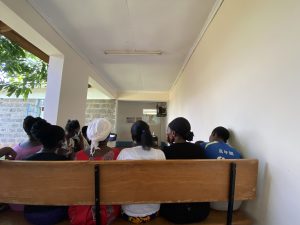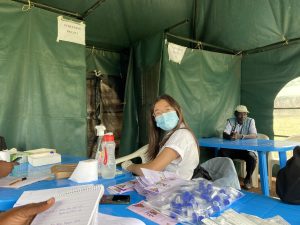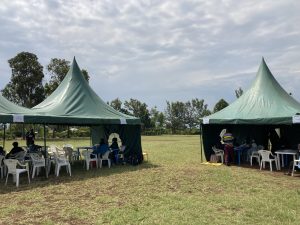First and foremost, we have passed the halfway point of our time in Kenya! Time flies by, and we are discussing what we want to get out of the next four weeks. Insofar, we collected more than 20 observation data to evaluate the workflow of stigma education at the clinic. During this process, we faced multiple hiccups, especially scheduling a visit and clearing up logistics. Three of our observation clinics had a twelve-day-long CHV training, so we had to flip our schedule to ensure we could collect the data we initially planned. We spent the last couple of days creating a contingency plan so that our time in Kenya could contribute to the depth of our data. Listening to what other teammates thought helped us, as a team, solidify the future direction of our study, such as what variables to analyze in observation studies, codes for focus group discussion, and the focus of our manuscript.
Besides working on an observational study, we are constructing a flowchart with key stakeholders and healthcare providers in Kisumu county and its three sub-counties. With the help of Sandra, Jeniffer, and CHVs, we hope to provide a  guideline for a future research team and increase efficiency in reaching out to the ‘right’ stakeholders without juggling administrative ladders. While the flowchart looks straightforward, following a hierarchical structure, we realized each sub-county has different health objectives and created different positions to achieve them. To get correct information, we asked multiple questions to CHVs, experts in their community, and the bridge between health administrators and us. It was a time-consuming task but a fruitful time to get to know each clinic and sub-county’s goals.
guideline for a future research team and increase efficiency in reaching out to the ‘right’ stakeholders without juggling administrative ladders. While the flowchart looks straightforward, following a hierarchical structure, we realized each sub-county has different health objectives and created different positions to achieve them. To get correct information, we asked multiple questions to CHVs, experts in their community, and the bridge between health administrators and us. It was a time-consuming task but a fruitful time to get to know each clinic and sub-county’s goals.
Shifting the gear towards more positive anecdotes, I saw a silver lining from observing clinic sites. When CHVs delivered health talks on the importance of  HPV testing and cervical cancer prevention, male patients, waiting to see their providers, actively engaged in learning more. Some of them followed up with questions about CHVs, such as how to prevent HPV transmission and male HPV infection risks, which brought me the question ‘what is the best way to mobilize men to advocate cervical cancer prevention?’ As I learned in Dr. Huchko’s sexual and reproductive health class, male support plays a grave role in reducing female stigma in reproductive healthcare then I believe that the next question we have is finding what motivates these men to learn and act.
HPV testing and cervical cancer prevention, male patients, waiting to see their providers, actively engaged in learning more. Some of them followed up with questions about CHVs, such as how to prevent HPV transmission and male HPV infection risks, which brought me the question ‘what is the best way to mobilize men to advocate cervical cancer prevention?’ As I learned in Dr. Huchko’s sexual and reproductive health class, male support plays a grave role in reducing female stigma in reproductive healthcare then I believe that the next question we have is finding what motivates these men to learn and act.
 On Saturday, the 25th, the team went to Nyakach to help U54 campaigns. Each of us helped with different sections, such as putting vaccination information, HPV self-sampling participant demographics, and double-checking serial numbers on the sample tubes. Observing a different workflow under the tent to what we have seen at clinics for the past weeks was refreshing enough to make me think about how to build a ‘sustainable’ mobilization strategy to increase community awareness of cervical cancer. Now that I have seen community-based and facility-based interventions, I hope to provide a better blueprint for bringing social interest into reproductive health.
On Saturday, the 25th, the team went to Nyakach to help U54 campaigns. Each of us helped with different sections, such as putting vaccination information, HPV self-sampling participant demographics, and double-checking serial numbers on the sample tubes. Observing a different workflow under the tent to what we have seen at clinics for the past weeks was refreshing enough to make me think about how to build a ‘sustainable’ mobilization strategy to increase community awareness of cervical cancer. Now that I have seen community-based and facility-based interventions, I hope to provide a better blueprint for bringing social interest into reproductive health.
Personally, this summer is special for me because I am turning 21 this summer! Living in a different country to research is already a unique experience, and celebrating my birthday there is a cherry on top. To be honest, I had multiple challenges this summer: I was stuck at JFK for six hours, had to fly to Nairobi for my graduate school exam, and had multiple non-COVID-related (finally!) logistical delays the team did not even know 24 hours before it happened. However, how would I know what the actual “global” health research is if I was not here? I look forward to seeing what the next three weeks will throw on me.
